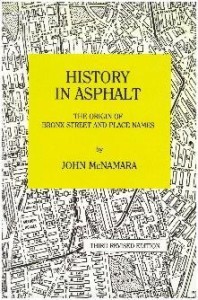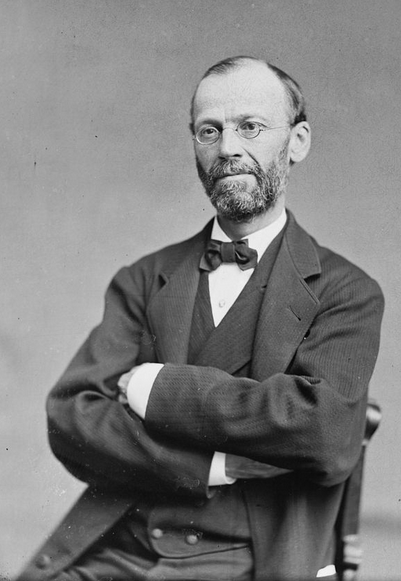
The old Givan House behind the Baychester Post Office. Image via forgottenny.org
My favorite book in the world is “History In Asphalt“, an encyclopedia of  Bronx street names written by the late John McNamara. (All apologies to Zadie Smith, Richard Russo and Jennifer Egan…) When you look at the Bronx around you, you see the Bronx around you. After spending time with this book, you can see the Bronx the way it is and the way it was.
Bronx street names written by the late John McNamara. (All apologies to Zadie Smith, Richard Russo and Jennifer Egan…) When you look at the Bronx around you, you see the Bronx around you. After spending time with this book, you can see the Bronx the way it is and the way it was.
(Buy it here from the Bronx Museum of The Arts.) (Shoutout to reader Miriam Tabb.)
Ely Avenue
“It is named for Smith Ely, Mayor of New York 1877-1878. At its southern end, Ely Avenue overlays the former Givan’s Creek and mill that were landmarks of the 19th century. Directly after the Revolutionary War, Robert Givan purchased the land from the Bartow family, the tract extended to Boston Road, east of Eastchester Road.
The name of the estate was “Ednam”, and it remained in the family for four generations, later to be sold as a real estate venture called “Pelham Bayview Park” (1895-98). Ely Avenue in part overlays the ancient boundary watercourse called Black Dog Brook that separated  Eastchester from Westchester.
Eastchester from Westchester.
Above Boston Road, the avenue was once called Doon Avenue. Above Nereid Avenue, its older name was Bayard Street, honoring Nicholas Bayard, a Mayor of New York in 1685. Smith Ely died in 1911″–John McNamara
Smith Ely, Jr. (April 17, 1825 – July 1, 1911) was the 82nd Mayor of New York City and member of the United States House of Representatives from New York.
Born in Hanover Township, Morris County, New Jersey in 1825, he completed preparatory studies and was graduated from the University of the City of New York (now New York University) and, in 1845, from New York University School of Law.[1] He was admitted to the bar the same year, but never practiced law. Instead, he engaged in mercantile pursuits in New York.
He was active in various public offices:
- school commissioner, 1856–1860;
- state senator, 1858 and 1859;
- county supervisor, 1860–1870;
- commissioner of public instruction, 1867;
- Democratic Representative to the Forty-second Congress, March 4, 1871 – March 4, 1873; ‘not’ a candidate for renomination in 1872;
- Representative to the Forty-fourth Congress, March 4, 1875, to the date of his resignation, December 11, 1876; chairman, Committee on Expenditures in the Department of the Treasury; and
- mayor of New York in 1877 and 1878.
In 1895, he was appointed commissioner of parks and served until 1897, when he retired from public life. In 1911, he died in Livingston, Essex County, New Jersey, where he was interred in a private cemetery on his farm. –via wikipedia
Why Ely Avenue today? Well, we had a request from someone in the Wakefield Facebook group I believe. Ely is near Eastchester Road, which was covered earlier this week, one of the boundaries of the Givan Estate. I’ve done Cruger and Barnes so far as well, so stay tuned tomorrow for….haven’t decided. Considering a street or two that connect the East Bronx to the West Bronx. Requests considered.













Follow Us